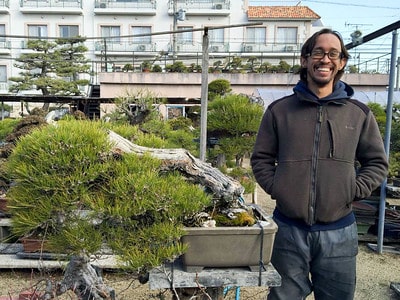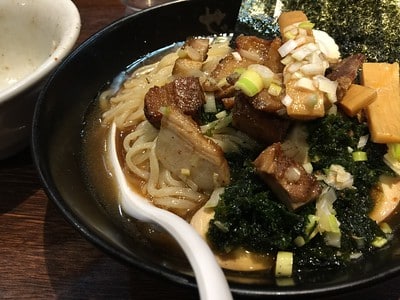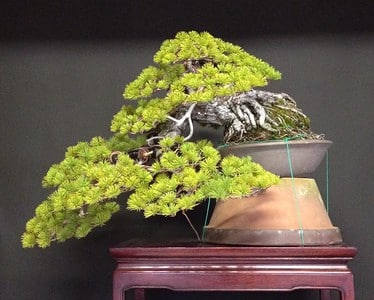Last month, Juan Andrade responded to questions posed via Ask Me Anything (AMA) at Ask Bonsai Tonight. Jeremiah Lee was at Aichi-en studying with Junichiro Tanaka at the time and coordinated with Juan to make the AMA happen. Juan has been very generous with his time and has provided responses that shed light on his experience as an apprentice in Japan.

Juan Andrade – photo courtesy Jeremiah Lee
For those who aren’t familiar with him, Juan Andrade is a bonsai artist from Santa Ana, Costa Rica. A passion for bonsai has led Juan around the world in search of bonsai knowledge. I met him during a period of study with Boon Manakitivipart, and Juan later studied at Rosade Bonsai Studio in New Hope Pennsylvania.
Today he is an apprentice at Aichi-en in Nagoya, Japan. His work is fantastic. If you don’t already, I recommend following his updates on Facebook at Juan Andrade Bonsai.
Below are the questions that have been answered to date. I’ll provide updates as additional responses come in.
And do note, another AMA is on the way – details coming soon!
Q: We hear a lot from black pine, red pine and white pine being used as bonsai in Japan, and I know how special black and white pine can be to the japanese. But are there other pine species in Japan? what are they if any and are those being used for bonsai too? I would like to know if anyone is working with Surasshumatsu (スラッシュマツ ) as a 盆栽 in Japan. It is the only pine that is readily available where I live.
– Xavier
A: Black, red and white pines certainly dominate the Bonsai scene here. There might be others pine species present in the Japanese islands that I am not aware of. At least in the Nagoya area, which is central Japan, I have seen Mughos and Scots pines used as Bonsai. In two years, I can count them on the palm of my hands. I have also seen hybrids between black and red pines , but the leaf quality is not so good (the needles tend to twist on those, and sometimes heavily). No Pinus elliottii either, sorry wink Are you treating them as a black pine? Luckily, there is an impressive amount of cultivars amongst the traditional pine species: my favorite ones currently being ‘gansekisho’ red pine, ‘nasu’ white pine and ‘kotobuki’ black pine.
Q: What’s your favorite thing to eat in Japan?
– Jeremiah
A: Hands down my favorite is Ramen, specially pork based broth with lots of garlic.

Ramen – photo courtesy Jeremiah Lee from his recent posts about Aichi-en
Q: Would you please tell us about the different cut pastes you use at Aichi-En?
– Jeremiah
A: 90% of the time we use a product called “Jointcaulk-A”. Technically, its an elastomeric sealant.Its waterproof and it never goes hard even after years out there in the sun. This is quite beneficial for rapid callous formation for several reasons: 1. Because its stays soft for a very long time, its easy for the callous to roll under it and push it off. Removing it is quite easy as well. 2. Because its hydrophobic when dry, it prevents water from entering the wound but it also protects the callous tissue from drying out. 3. It’s dark in color. Oyakata believes callous grows better when not exposed to light (same idea as the aluminum foil trick for covering japanese maple wounds). These caulking compounds are usually made of silicone, latex or polyurethane. I know the silicone one is used in the satsuki field-growing operations. The one available here is latex-based. The one I get back home is polyurethane-based and it works fine as well. These kinds of sealants work so well that they produce a thick, fast-growing callous. Sometimes we want a flat, slow growing callous so the wound is less visible (typically in older more refined trees). In these cases we use electrician’s putty, which the cost-effective version of the typical putty-type cut paste often sold for bonsai purposes.
Q: Do you have any long term or short term goals related to Bonsai?
– Jeremiah
A: I don’t know whether this will be short or long-term, but my priority now is to get acquire sufficient skill for my Master to consider me ready to go home. I do think, of course, of a business of my own in the near future. Ideally It would be a nursery / school dealing with high quality bonsai (collected conifers and field grown deciduous).
Q: How do you encourage Acer Palmatum to close large wounds (other than time)?
– Scott
A: There are several large japanese maples that we have in the nursery which are in the process of wound healing (yamamomiji, arakawa and some red-leaf cultivars). The normal japanese maples and arakawas are strong enough to heal large wounds in a pot. The are planted in soil media with 20-30% more river sand than normal (drier mix means stronger root growth, which is reflected by stronger top growth). Those are not pinched in the spring, nor partially defoliated. They are just allowed to run strong for the entire growing season and not cut back. They are watered very heavily. We used the joint-caulk cut paste on them. The arakawa has a wound about 6 inched across at its widest point. I have monitored this particular wound for the last two years and the callous seems to spread about an inch per year. The trees have not been repotted so far. Usually, after re-potting, maples slow down a bit but their vigour increases greatly in the second and third year. The red-leaf cultivar just went straight into the ground. Being a bit weaker that regular momiji, growing in the ground or in a raised bed gives then best chance of healing wounds.
Q: Who is your favourite potter?
– Scott
A: I like old japanese pots. Collectively they are called “wabachi”. The glazed ones have a rustic feeling to the clay (usually cream colored clays) and the glazes themselves are thick and multi-colored and sometimes feature ” glaze drips”. The unglazed ones are usually red-clay with heavy patina on them They have a burnished polished feel and sometimes one can find patinas good enough to match chinese antiques. For a low-wage apprentice like me, they are the ultimate “bang for your buck” pots. To properly answer your question, out of the modern japanese potters, I like Syuzan and Sensyu pots (I can blame Peter Tea for that), though they are often out of my budget LOL.
Q: Initially, how are root over rock bonsai best attached to the rock? wire, foil, string, other?
– Scott
A: Aichi-En is reputedly one of the places that first started making trident maples root over rock, particularly cascading tridents over tall stones. Oyakata’s grandfather tied the maples roots to the rock with steel wire. You might think that is a bit harsh, but the since the trees were developed in the field, the sheer strength of the root growth made them push and detach themselves from the rock over time. Because of this, he used the strongest wire available at the time. In theory, the idea was that the roots eventually engulf the wire and heal the over the wire scars. In practice (and in the long run) the better ones did heal over the wire scars, but you still you can find traces of wire scars on most of them if you look closely. In some cases the steel wire oxidized and I think it might have caused rotting and decay of the inner wood of the fused roots. If you are doing a big project in the field, I would recommend you thin stainless steel (thin wire= thin wire scars that heal easily). For smaller, slower growing projects ,I would recommend any strong non-stretch material that you can bind the roots with tightly and does not bite into them, like a flat plastic rope .
Q: Why did you pick Aichi-En as your location to study?
– Jeremiah
A: There are several kinds of bonsai nurseries in japan that tend to specially in certain areas of the business: field growing or collecting, development or structure making, refinement, maintenance, reselling, etc. Aichi-En falls broadly into structure-making and refining for customers. We do a little bit of filed growing as well , and we take care of several Kichou (important masterpiece Bonsai) for high-end customers. So making the decision to come here was not hard in the sense that I would have been getting a balanced education in Bonsai making. Peter Tea’s recommendation was very important to me., and once I came here for the first time as a visiting apprenticeship I fell in love with the place and the working environment. A big plus is that Oyakata is generous, kind, polite and overall awesome dude to go around with and learn from.

White pine – photo courtesy Juan Andrade
Q: Do you plan to spend any time in the US after your apprenticeship teaching?
– Jeremiah
A: When I came to Japan for my apprenticeship, I had to (in many ways) let go of things that tied me down to my homeland. I don’t know exactly when my apprenticeship will be finished, but I am aware that business is picking up in the US (and maybe not so much in Costa Rica). So even though my original plan was to return to Costa Rica, I now realize that travel and work within the US and quite possibly moving there is a strong possibility.
Q: Can you elaborate a little on methods used in Aichi-en to encourage Ume to bloom?
– Pedro
A: If grown from seed, Ume can be very unreliable when come to producing flower buds. There is a specimen Bonsai Ume in the garden here that is 125 years old and some branches on that tree have never flowered!! Of course, this specimen has never been grafted. Is your Ume tree young? Is it healthy? Usually these are the main reasons a tree is not producing flower buds. But young and vigorous trees can be easily grafted with cultivars that flower reliably. The best time to graft is early spring. We do side grafts with a baggie covering the graft, we put a bit of sphagnum inside to keep the moisture up. White flower types are usually used as under-stock for grafting red flower types, but I have seen the reverse done as well. Just depends on your flower preferences. In Japan, red flower types are popular because they ramify better than the white types. Older trees can be noticeably hard to graft, and it’s almost a requirement to get them strong prior to grafting. A 50% success rate is pretty good on them, 75% means your grafting skill if awesome! ![]() I want people to loose the fear of grafting their trees. It is a fun, easy way to improve the quality (branches, flowers) of your Bonsai. If grafts fail, no harm done. Trees heal and we can always try again next year. Good luck and I hope you consider grafting your Ume!
I want people to loose the fear of grafting their trees. It is a fun, easy way to improve the quality (branches, flowers) of your Bonsai. If grafts fail, no harm done. Trees heal and we can always try again next year. Good luck and I hope you consider grafting your Ume!
Subscribe to Bonsai Tonight
New Posts Delivered Every Tuesday and Friday